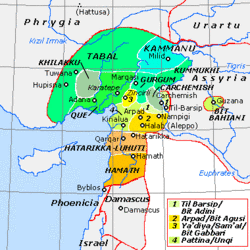Pattin/Unqi | |||||||||
|---|---|---|---|---|---|---|---|---|---|
| Before 870 BC–738 BC | |||||||||
 Pattin(a)/Unqi and its capital Kinalua among the Neo-Hittite states | |||||||||
| Capital | Kinalua | ||||||||
| Common languages | Luwian Aramaic | ||||||||
| Religion | Luwian religion | ||||||||
| Government | Monarchy | ||||||||
| Historical era | Iron Age | ||||||||
• Established | Before 870 BC | ||||||||
• Disestablished | 738 BC | ||||||||
| |||||||||
| Today part of | Turkey Syria | ||||||||

Pattin (also known as Pattina, Patina, Unqu and Unqi), was an ancient Luwian Neo-Hittite state at the beginning of the 1st millennium BC. It was known to the Assyrians as Unqi and Aramaeans as Unqu.
It was located at the north-western coast of ancient Syria, associated with the modern-day Hatay. The capital of the state was Kinalua (Kunalua, Kalneh, or Kinaluwa), which has been tentatively associated with Tell Tayinat [1] in modern-day Turkey.
The state was formed in the 9th century BC towards the end of the Dark Age period, and shared a north-western border with the Neo-Hittite state of Quwê. Khazazu (modern-day Azaz) was one of Pattin's dependencies which was invaded by Assyria around 870 BC. The frontier fortress of Aribua (associated with the modern-day region of Idlib) within the land of Lukhuti to the immediate south of Pattin was also ravaged. [2] [3]
